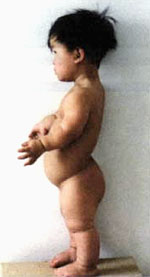Achondroplasia - genetic disorder - dwarfism, symptoms and treatment

What is Achondroplasia and Dwarfism
Achondroplasia is a genetic disorder in which the rate CARTILAGE cells (chondrocytes) convert to BONE cells is greatly slower than normal, resulting in skeletal abnormalities such as shortened limbs and diminished height. Achondroplasia is the most common cause of SKELETAL DYSPLASIA, commonly called dwarfism. Though achondroplasia can occur as an autosomal dominant inherited genetic disorder, it more commonly occurs as a spontaneous MUTATION of a GENE on CHROMOSOME 4 that encodes fibroblast growth factors, the proteins that regulate cartilage cell conversion. Prenatal testing can identify whether a FETUS has achondroplasia, though doctors generally offer the test only when there is reason to suspect the condition could be present or along with other GENETIC TESTING. Because infants born with achondroplasia have distinctive physical features, the disorder is obvious at birth.
Symptoms of Achondroplasia
The characteristics of achondroplasia include
- enlarged head and prominent forehead
- short arms and legs
- short hands and short, thick fingers with a distinct separation between the middle and ring fingers
- abnormalities in the opening at the base of the BRAIN, the foramen magnum, and in the vertebrae that compress the SPINAL CORD, affecting BREATHING
- craniofacial anomalies such as narrow nasal passages, flat NOSE, and short jaw
Evaluation for an infant born with achondroplasia typically includes COMPUTED TOMOGRAPHY (CT) SCAN, ULTRASOUND, or MAGNETIC RESONANCE IMAGING (MRI) to evaluate the extent of skeletal anomalies, especially those that may affect the spinal cord and thus vital functions such as breathing. Some infants also have or develop HYDROCEPHALY (fluid accumulation within the cranium), which may require a shunt for draining the excess fluid. As they grow, children who have achondroplasia are vulnerable to KYPHOSIS (a hump in the upper back) and LORDOSIS (curvature of the lower spine). They are also susceptible to frequent OTITIS media (middle EAR INFECTION) because the shortened facial structures mean the eustachian tubes, valvelike structures between the middle ear and the THROAT, are also shorter than normal and do not function properly.
Achondroplasia Treatment
Though some children may benefit from bonelengthening operations, in most situations there are no treatments to normalize the development of bone. Bone-lengthening surgery is extensive and expensive, has significant risk for side effects (such as infection and permanent damage to the bones), and is controversial among medical experts. Some specialists use HUMAN GROWTH HORMONE (HGH) SUPPLEMENT early in the child’s life, though this is also controversial and does not produce predictable results. Adults who have achondroplasia generally reach a maximum height of about four feet.
See also EUSTACHIAN TUBE; GENETIC COUNSELING; GENETIC DISORDERS; INHERITANCE PATTERN; OPERATION; SURGERY BENEFIT AND RISK ASSESSMENT.
Open discussion on the topic Achondroplasia - genetic disorder - dwarfism, symptoms and treatment
Similar interests
- Nuovi Casino
- Casinos Not On Gamstop
- UK Casinos Not On Gamstop
- Casinos Not On Gamstop
- UK Casinos Not On Gamstop
- Casino Non Aams Italia
- Slot Sites Not On Gamstop
- Meilleur Casino En Ligne
- Non Gamstop Casino Sites UK
- Meilleur Casino En Ligne
- Casino En Ligne France
- Best Non Gamstop Casinos
- Casinos Not On Gamstop
- UK Casino Not On Gamstop
- Casinos Not Signed Up To Gamstop
- Best Slot Sites UK
- Non Gamstop Casino Sites UK
- Online Casinos Nederland
- Online Casinos Nederland
- Casinos Not On Gamstop
- Best New Uk Casinos Not On Gamstop
- Casino Non Aams
- Non Gamstop Casinos UK
- Migliori Siti Casino Non Aams
- Bitcoin Casinos